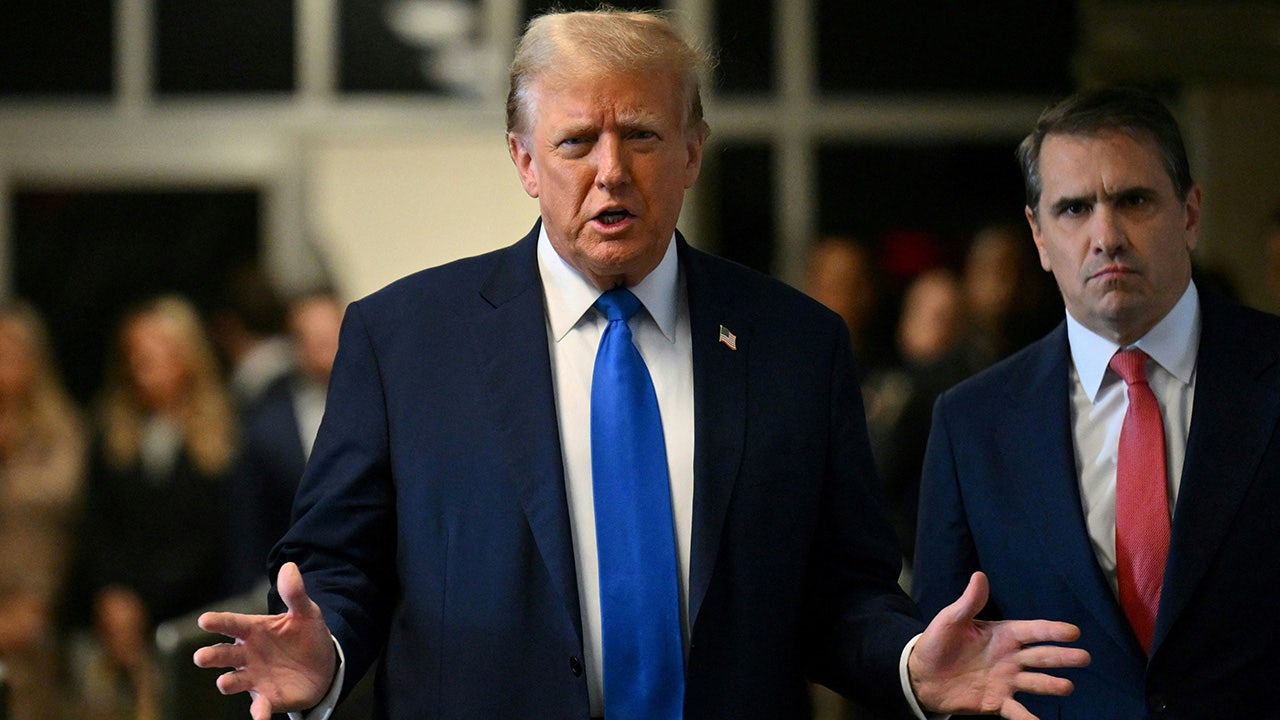Movie Reviews
Civil War | Review

Alex Garland’s Civil War depicts a fictional US conflict that is less about conveying a political perspective as it is a tense statement about the normalization of violence and collectively losing sight of the bigger picture.
Poignancy in film is sometimes on purpose, sometimes just coincidence. Civil War is a bit of both. Here is a film that recognizes the diplomatic atmosphere being as strained as it has been in a very long time, but also comes to theaters exactly at the right time when those conflicts are heightened to a worryingly improbable end. Civil War may depict a fictional conflict in the United States, but it’s message speaks to the global increase of violence in our lives driven by the splintering of society towards radical perspectives – in specific those who act upon them and those who pretend they aren’t a threat.
Those exact perspectives aren’t clearly defined in Civil War, which is a detriment to those viewers who are hoping the film will champion their own specific views. Instead, director Alex Garland makes the choice to not explicitly detail the cause of his fictional civil war, but instead realize the greater implications of that conflict on the general population. It recognizes the general opportunity of how things could get out of control here in the US, as if to demonstrate that the systems of our precious constitution are just as susceptible to abuse as anywhere else in the world.
Civil War
Directed By: Alex Garland
Written By: Alex Garland
Starring: Kristen Dunst, Wagner Moura, Cailee Spaeny, Stephen McKinley-HendersonRelease Date: April 12, 2024
By not providing a concrete reason for the conflict, Garland’s film suggests the flaws of humanity make it inevitable. He reinforces this theme by peppering in accounts of people who are pretending the war isn’t happening, as if to suggest their ambivalence played a role. The film contrasts the experiences of those people with their heads buried in the sand by spinning a narrative around those who are paid not to: war correspondents.
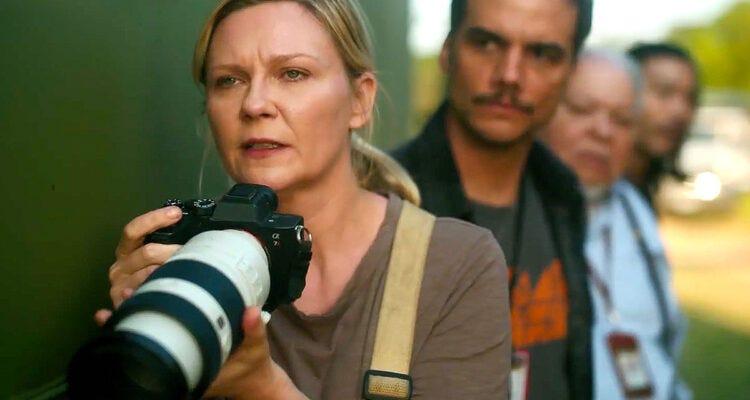
The story focuses on a renowned journalist Lee Smith (Kristen Dunst) who has made a name for herself covering harrowing atrocities across the globe, and her colleague Joel (Wagner Moura) who lives for the thrill of experiencing the thrill of battle in person. As the civil war is upon the precipice of conclusion, they decide to race to Washington D.C. to try and interview the President of the United states before he is captured by his opposition. In this journey they are joined by Sammy, a veteran reporter who would rather die than stop working (Stephen McKinley-Henderson), and Jessie (Cailee Spaeny), a young and inexperienced photographer who looks up to Lee.
Lee and Joel are an experienced 2-man crew who have been together through some very dangerous conflicts depicted to the audience through flashbacks. Sammy and Jessie’s involvement thus represents a hazard because they don’t just have to worry about themselves, they have to look out for two people who don’t have the same capabilities as they do. But while Sammy is willingly putting himself in danger and has the wherewithal to know exactly what he is getting himself into, Jessie does not. Joel and Lee’s opposing perspectives on the approach to their work is something that makes their working relationship function, but it creates conflict in regards to Jessie.
Lee is reluctant to bring Jessie in under her belt and show her the ropes because she has seen the worst of humanity and fears Jessie isn’t prepared for it both emotionally and physically. Lee doesn’t want to have to care about someone else because it may compromise her ability to do her own work. Meanwhile Joel is excited to be able to share his enthusiasm for being in the thick of the battle and wants to help Jessie experience this for the first time. For her part Jessie realizes the uncomfortable burden her presence places on the group, but knows that if she wants to further her career this is a golden opportunity she would never get if she played it safe.
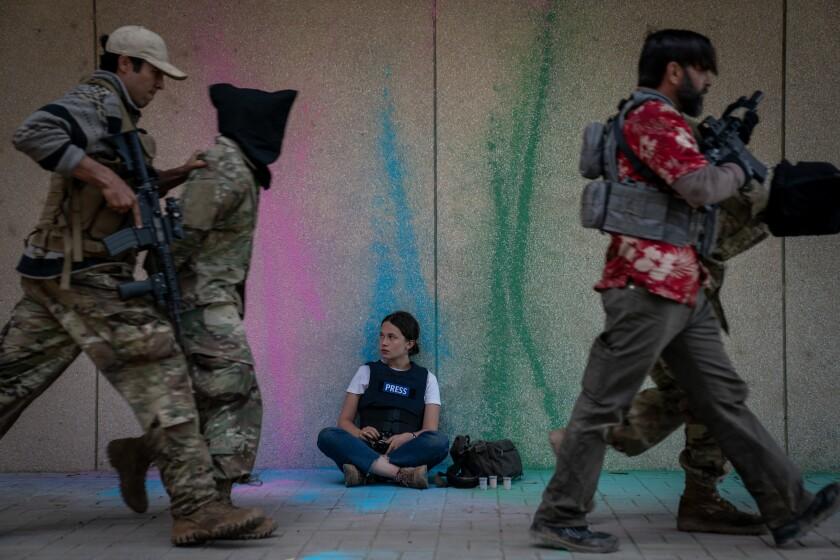
In this way, all of them essentially exploit the pain and suffering of others for their living. This experience has essentially numbed them to the motivations of the conflict, which is part of the reason why the film doesn’t spend time commenting on them. Furthermore, it isn’t really possible for Lee & Company to be on one side or the other because the integrity of their craft and personal safety requires them to be ambivalent. In many ways they hide behind it like a shield. While they can’t ignore the conflict, their reasoning to not be on one side or the other is just as selfish as those who are ignoring the conflict.
You could construe this as a criticism of the media, which I think may be valid. But I think the point is the fact that our society is at a point where “sides” are necessary in the first place. This is a bigger criticism of the world’s social development as a whole. Rather than be motivated by the greater good, we’re motivated by selfish desires and we channel that into picking “sides”. At one point in the film, the main characters encounter a man with a gun who has captured and tortured two men because they were stealing from him. He comments on how he had gone to high school with one of them, suggesting the extremes that have become necessary – even in a civilized first-world nation – for individual survival.
Director/writer Garland first made a name for himself in cinema by reinventing the zombie genre for the 21st Century with his script for 28 Days Later. In many ways, Civil War feels like a zombie movie. The world it depicts has fleeting reminders of normalcy amidst a harrowing almost post-apocalyptic fight for survival. There are gripping action sequences with sound design that pummels you into the back of your seat. And yet most of the film is quiet, expressing the void of humanity from this possible future. Garland depicts empty streets with the occasional roving military vehicle, others are littered with the carcasses of cars and equipment abandoned long ago. Like a zombie movie it hinges on humanity’s hubris – despite all our impressive accomplishments we’re still a deeply flawed species.
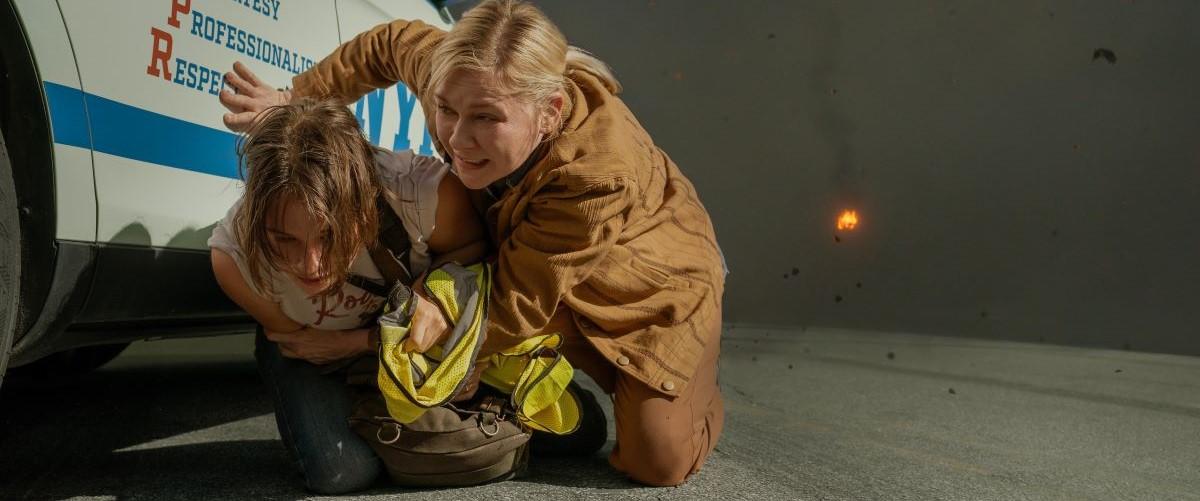
Kristen Dunst portrays Lee the entire film with the aghast expression of someone who has seen too much. But Jessie’s inclusion in her life is what ultimately breaks her. Not because she witnesses her loss of innocence first-hand, but because Lee sees herself in Jessie. From this outside perspective Lee begins to feel the guilt that she had hid away for all these years. Reporting on these terrible events doesn’t necessarily bring heightened concern from the general public, instead it fuels our tolerance for them.
Civil War offers us the ultimate paradox of our modern information age; the more we know about what is going on, the worse off we are. Truth becomes the enemy not because of what it means to us, but because of our selfish reactions towards it. The film conveys a pulse-quickening tale of survival in a harrowing dystopia of fear towards knowledge. It flies in the face of every horror film where we’re told that the most frightening thing is the unknown.

Movie Reviews
Movie Review: The Fall Guy – CinemaNerdz
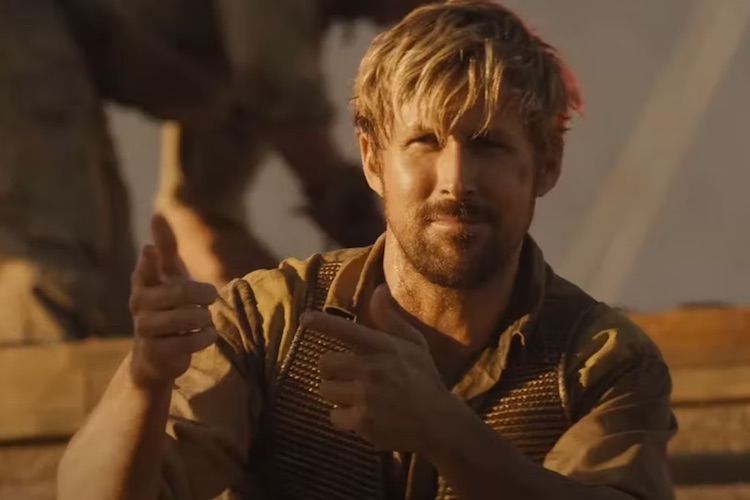
Based on the television show of the same name that ran for five seasons from 1981-86 and starred Lee Majors and Heather Thomas, director David Leitch’s new film, The Fall Guy, employs the same combination of action and sexual tension that fueled the show (albeit not necessarily between the two main characters). This approach makes for an entertaining and somewhat nostalgic aura around a film that, if approached a different way, could have resulted in another disappointing cinematic adaptation of a popular television property.
Colt Seavers (Ryan Gosling) is a stuntman at the top of his game. He is performing death-defying stunts alongside his wannabe director girlfriend Jody (Emily Blunt) until one stunt goes awry and a severely injured Colt all but retires from the profession. That is, until his services are requested on the film that his now ex-girlfriend Jody is making her directorial debut with. The prospect of making peace with her entices him to take up the mantle of stuntman again. When he gets on set however, he quickly learns that there is more to his emerging from retirement than simply performing a few stunts as the star of Jody’s film (played by Aaron Taylor-Johnson) has disappeared and the film’s producer Gail Meyer (Hannah Waddingham) enlists Colt to track him down and bring him back to set. Of course, this is easier said than done and Colt soon finds himself embroiled in a conspiracy that could derail not only his reconciliation with Jody, but her career as well.
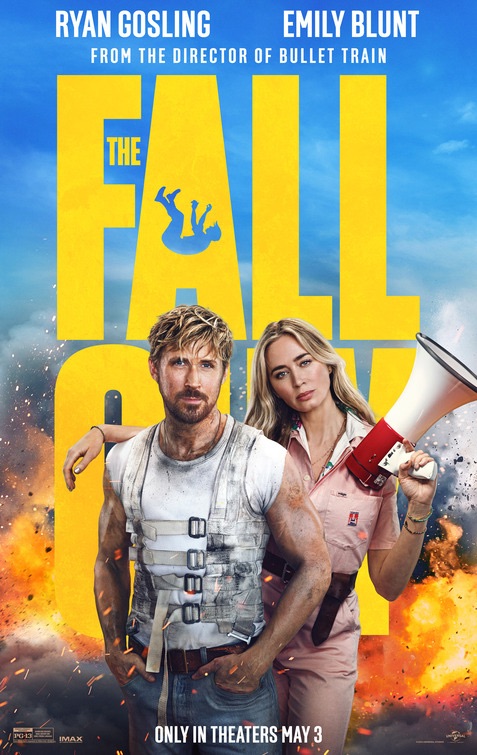
Like he has done with films like Bullet Train (2022) and Deadpool 2 (2018), director David Leitch shows off his ability to deliver action sequences that invigorate a rather tepid plot (as in the case of Bullet Train), but also showcase a well-written story centered around a likable character played by a charismatic actor (i.e. Deadpool 2). Working from a script by Drew Pearce (whom he collaborated last with making 2019’s Fast & Furious Presents: Hobbs & Shaw), Leitch embraces the entertainment value of the original property without resorting to a camp approach as have many other television adaptations. What emerges is an action/adventure piece with a legitimate mystery for the hero to solve while simultaneously trying to get his life back on track.
As Colt, Gosling does a fine job of blending the character’s natural suave demeanor with the uncertainty he is facing during this crossroads moment of his life path. Likewise, Blunt is equally capable as the talented filmmaker who is unsure exactly why her former flame has shown up on her set after so much time away. Taylor-Johnson embraces the bombastic nature of his character as a spoiled star too used to getting his way.


Ryan Gosling in “The Fall Guy.”
Nods to the original television show, courtesy of David Scheunemann’s production design, including Colt’s iconic truck, prove a welcome and non-distracting homage to the series. Along with Leitch’s use of movement to capture the action sequences, the editing provided by Elísabet Ronaldsdóttir allows the film’s action sequences to move along at a brisk and well-paced speed.
The nostalgic and non-ironic adaptation of the television series The Fall Guy allows the film to stand on its own apart from its namesake property (although there is a cameo at the end of the credits featuring original stars of the series) and exist as its own successful action/adventure film.
Movie Reviews
‘Tarot’ movie review: Thrills and chills aren’t in the cards for this routine horror film

NOW STREAMING ON:
A group of college students are violently killed one-by-one after a fateful tarot reading in the frightfully unimaginative Tarot, which opens in Prague and cinemas worldwide this weekend. Following in the well-worn footsteps of tepid horror films like Ouija, Truth or Dare, and Wish Upon, this one is painfully obvious from the word go, but never gets silly enough to provide any bad-movie fun.
Last year’s monkey paw chiller Talk to Me suggested brighter things on the horizon for this type of horror movie, but Tarot dials things back to the same narrative these things have been following for decades: group of college students plays around with supernatural object they don’t understand, and quickly comes to regret it. This very specific sub-genre’s roots lie in early 2000s successes like The Ring and Final Destination.
Tarot opens with a group of largely interchangeable Boston-area college students played by Harriet Slater, Humberly González, Larsen Thompson, Avantika, Wolfgang Novogratz, Adain Bradley, and Jacob Batalon (Spider-Man: No Way Home) during a weekend retreat at an isolated manor in the Catskills (played by locations in Belgrade, Serbia). Desperate and out of booze, they search the weekend rental for a hidden stash but only turn up a box of creepy hand-illustrated tarot cards.
No alcohol? Sure, some tarot readings from this musty old deck will liven up the party. But when those readings start coming true over the following days, things start to take a dark turn. Waitaminute… surely all of these characters didn’t get a reading implying imminent violent death? No, they did not. But they did draw a creepy central card that comes to life to murder them in ways hinted at by the literal language of their reading.
In past films of this type, the characters would have to visit a library and scan microfiche to uncover the true horror behind the curse that stalks them. But in Tarot, that kind of thing is just a Google search away. In fact, there have been multiple cases of young adults mysteriously dying after tarot readings, though our protagonists have to pay a midnight visit to a tarot expert with pinboard walls (Mandy‘s Olwen Fouéré) to get the full story. It involves a royal astrologer in old Hungary, an ancient curse, and an expedient five minutes of climactic exposition.
The saving grace keeping Tarot from the bottom of this horror barrel is the novelty of the tarot cards themselves, which are nicely illustrated and lead to some briefly appealing creatures. Despite working with a script that couldn’t have inspired much confidence, the effects team, at least, gives this movie more effort than it deserves.
There’s precisely one engaging death scene here, a magician-inspired sequence that features a character hiding in a box… no prizes for guessing what happens. While the setting is transposed from what should be 17th century Hungary to 1920s vaudeville, the vibrant makeup effects used to set the scene evoke some Insidious-like goofball hellscape vibes, and provide a taste of the kind of horror stylings the rest of the film could have desperately used.
Tarot is based on the 1992 YA novel Horrorscope, written by the pseudonymous Nicholas Adams, which focused on daily hororscopes rather than tarot cards. It was directed by Spenser Cohen (co-writer on The Expendables 4 and Moonfall) and Anna Halberg, who previously collaborated on the fictional horror podcast Classified. But the end result leaves you feeling as if an algorithm is the true brainchild behind the story; this PG-13 movie about a group of college students who play around with a cursed deck of tarot cards certainly won’t surprise anyone who has the poor fortune of stumbling upon it.
Movie Reviews
The Idea of You Movie Review: Anne Hathaway’s honest performance makes the film stand out in a not so formulaic rom-com
)
Anne Hathaway’s The Idea of You showing on Amazon Prime Video is pure fluff which will make you feel happy. And with so much happening around us, we really need movies like this.
read more
No it is not a regular fan fiction. In fact, it is not a fan fiction at all. For me, it is why sadistic people around us hate happy women. When you hit rock bottom emotionally, you will find people loving you and caring for you. But when you are happy and at the high in your life, then people start having problems.
Anne Hathaway’s
The Idea of You
teaches you when you hit rock bottom, you have nowhere to go, but up. That’s exactly what happened to Solène (Anne Hathaway), a recently divorced woman just about to hit 40. She unknowingly lands up in a relationship with a British boy band sensation Hayes Campbell (Nicholas Galitzine).
Solène is in a dilemma because Campbell is way younger to her and on top of that he is the heart throb of many young girls. And he is hugely rich and famous too. It is just that Solène (Anne Hathaway) didn’t know who he was. Solène is a stylish woman who was initially unimpressed by his celebrity status. The Idea of You is a fresh take on the popular rom-com-drama formula
The initial part of the film deals with how she has still not come to terms with her sudden divorce and how she was the last one to know that her husband was cheating with her. She got married young and had a baby was very early on life and while she was struggling with motherhood and setting up her art gallery, the husband was having an affair with a lawyer from his firm. The wound of her husband cheating on her is still raw and she is still dealing with it. Burdened with responsibilities of motherhood and loneliness, she really doesn’t know what she wants from life.
Even when Solène (Anne Hathaway) meets Hayes Campbell (Nicholas Galitzine) she is totally confused. Campbell is in his twenties and madly in love with her. She feels that the relationship with a young man just doesn’t fit in her life and on top of that she has got a young girl. But she can’t stop herself from meeting him and being loved by him. Yet at the back of her mind there is always that feeling of guilt and things get worse when the intimate images of her and Hayes Campbell (Nicholas Galitzine) got leaked on the internet. She gets slut-shamed by Campbell’s fans.
The Idea of You is a feel good film and most importantly it is always refreshing to see good looking actors on screen. And with Anne Hathaway flashing her million-dollar dolphin smile every now and then, you definitely can’t take your eyes off her. The place where both Solène (Anne Hathaway) and Hayes Campbell (Nicholas Galitzine) are in an intense kissing scene and she, a single mother of a teenage daughter, stops herself from getting more intimate by saying, “I could be your mother.” And to this Hayes quickly says, “But you are not.” So, that’s the whole dilemma of Solène.
There is something very pure and beautiful in the way the love between the two are shown. Never for once, will you feel the relationship to be dirty. The simple love and attraction between the two is shown in such a beautiful way makes it a great weekend watch. The music, the styling, and the outfits are great. The story is simple and pure fluff, so just enjoy it!
Rating: 3 out of 5
-

 News1 week ago
News1 week agoLarry Webb’s deathbed confession solves 2000 cold case murder of Susan and Natasha Carter, 10, whose remains were found hours after he died
-

 Education1 week ago
Education1 week agoVideo: Dozens of Yale Students Arrested as Campus Protests Spread
-

 World1 week ago
World1 week agoHaiti Prime Minister Ariel Henry resigns, transitional council takes power
-

 News1 week ago
News1 week agoFirst cargo ship passes through new channel since Baltimore bridge collapse
-

 World1 week ago
World1 week agoUS secretly sent long-range ATACMS weapons to Ukraine
-

 World1 week ago
World1 week agoSpanish PM Pedro Sanchez suspends public duties to 'reflect'
-

 News1 week ago
News1 week agoAmerican Airlines passenger alleges discrimination over use of first-class restroom
-

 World1 week ago
World1 week agoAsia bears biggest climate-change brunt amid extreme weather: WMO













